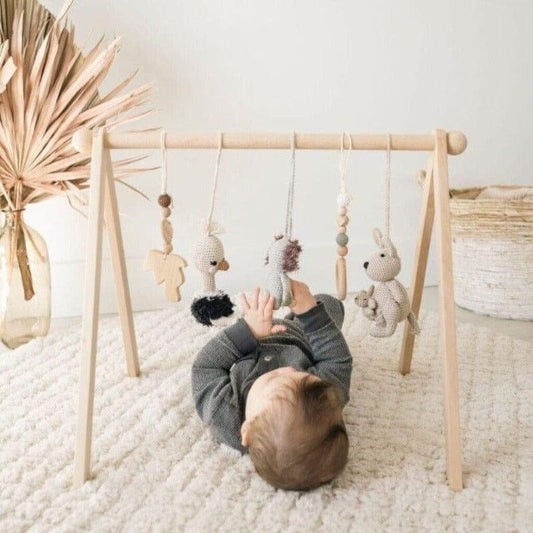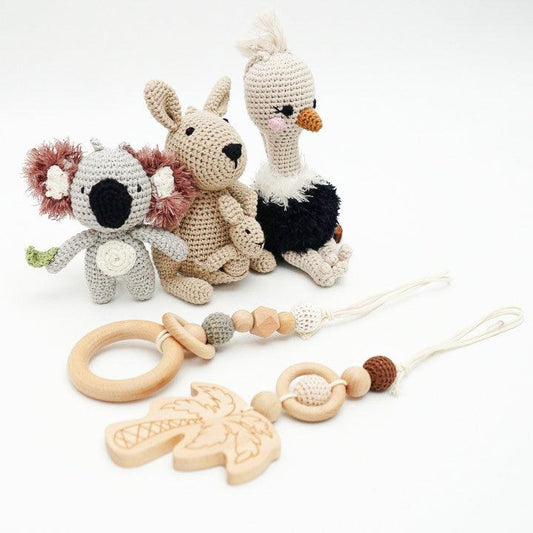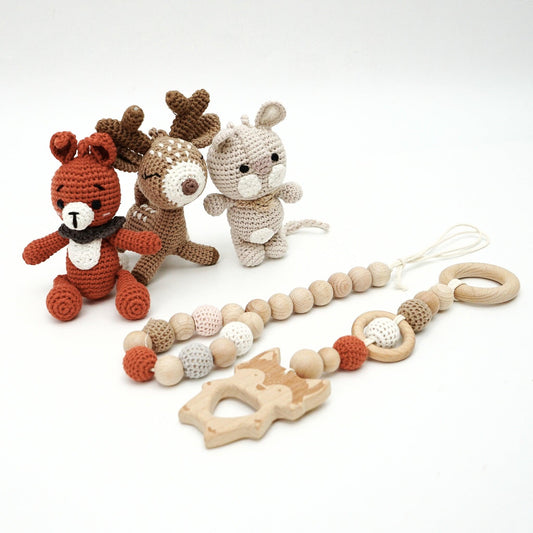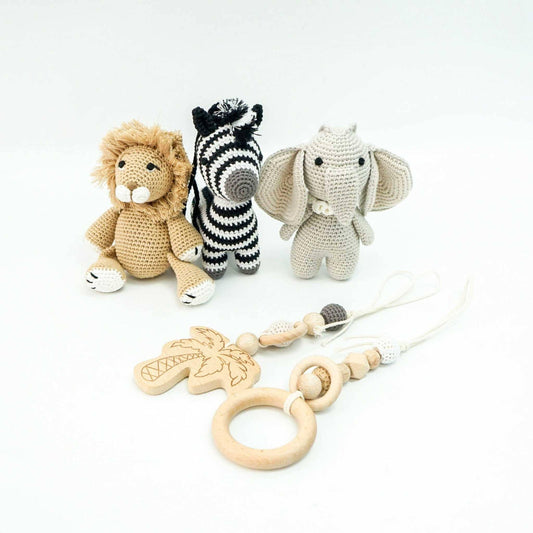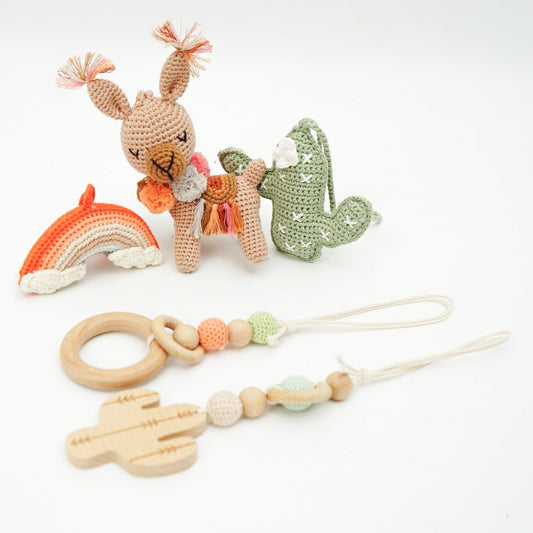-
-
._ ?
Handmade Crochet Toys for Baby Gym | Australian friends
Rated 4.7 out of 5$84.99 -
._ ?
Handmade Crochet Toys for Baby Gym | Forest Family
Rated 4.7 out of 5$84.99 -
._ ?
Handmade Crochet Toys for Baby Gym | Safari
Rated 4.7 out of 5$84.99 -
._ ?
Handmade Crochet Toys for Baby Gym | Boho Desert
Rated 4.7 out of 5$84.99 -
._ ?
Handmade Crochet Toys for Baby Gym | Flamingo Dreams
Rated 4.7 out of 5$84.99 -
._ ?
Handmade Crochet Toys for Baby Gym | Farm House
Rated 4.7 out of 5$84.99 -
._ ?
Handmade Crochet Toys for Baby Gym | Savanna Friends
Rated 4.7 out of 5$84.99 -
The Ultimate Guide to Montessori Baby Gyms and Play Mats: Nurturing Development Through Mindful Play
Embracing the Montessori Approach with Jabaloo Baby Gyms
At the heart of Montessori education lies a profound respect for a child's natural developmental journey. Jabaloo's exquisitely crafted baby gyms and play mats embody this philosophy, providing thoughtfully designed environments where your little one can explore, discover, and grow at their own pace. Unlike conventional plastic toys that overwhelm with lights and sounds, our Montessori-inspired wooden baby gyms honor your child's innate curiosity and capacity for self-directed learning—a cornerstone of the Montessori approach that fosters independence from the earliest stages of life.
The Developmental Benefits of Wooden Baby Gyms and Play Mats
Jabaloo's premium wooden baby gyms support multiple aspects of your baby's development through intentional design. The natural wood construction offers varied tactile sensations that stimulate sensory development, while suspended elements at different heights encourage reaching, grasping, and eventually batting—developing crucial fine and gross motor skills. As your baby interacts with our play gyms, they're building neural pathways that strengthen hand-eye coordination and spatial awareness. These seemingly simple interactions lay the groundwork for cognitive development, problem-solving abilities, and even early mathematical concepts—all while your baby simply experiences the joy of discovery.
Natural Materials for Mindful Development
Maria Montessori emphasized the importance of natural materials in children's learning environments, understanding that these materials provide authentic sensory experiences that synthetic alternatives cannot replicate. Jabaloo's commitment to using sustainably sourced woods and organic cotton in our baby gyms and play mats honors this principle, creating a connection to the natural world while offering varied textures, weights, and sounds for your baby to explore. The warm feel of wood, the gentle weight of organic cotton rings, and the subtle natural scents engage multiple senses simultaneously, creating rich neural connections during this critical period of brain development.
Creating the Perfect Prepared Environment
The concept of the "prepared environment" is fundamental to Montessori education—a thoughtfully arranged space that enables independent exploration and learning. Jabaloo baby gyms serve as your infant's first prepared environment, offering just enough stimulation without overwhelming. The clean lines, natural colors, and purposeful design elements provide clear visual focus points that help develop concentration—a skill that will benefit your child throughout life. By positioning your Jabaloo play mat in a calm, well-lit space free from excessive distractions, you're creating the ideal conditions for deep engagement and meaningful developmental work, as Montessori would call it.
Supporting Your Baby's Natural Developmental Timeline
Montessori education recognizes that children move through developmental stages at their own pace, and Jabaloo's play gyms are designed to accommodate this natural progression. In the earliest weeks, high-contrast elements support visual tracking, while ergonomic play mats provide ideal support for essential tummy time. As your baby grows, suspended elements at varying heights encourage reaching and grasping, eventually transitioning to sitting and exploring objects from new perspectives. Unlike age-restrictive toys, our Montessori baby gyms evolve alongside your child, offering new challenges and discoveries as their abilities expand—respecting the uniquely individual timeline of your baby's development.
Fostering Independence Through Purposeful Design
One of the most beautiful aspects of Montessori education is its emphasis on fostering independence, and Jabaloo baby gyms are thoughtfully designed to support this goal from infancy. The accessible height of hanging elements enables babies to activate cause and effect through their own movements, providing immediate feedback that builds confidence and a sense of agency. As they discover "I can make that happen!" moments, babies develop an early understanding of their own capabilities. Our play mats provide just enough support without restricting movement, encouraging babies to develop strength and coordination at their own pace—the first steps toward physical independence that will eventually lead to crawling, standing, and walking.
The Role of Observation in Montessori-Inspired Play
Montessori education places great emphasis on the adult as an observer rather than a director of a child's activities. When you introduce your baby to a Jabaloo play gym, you're invited to step back and witness their natural inclinations and interests unfold. Through careful observation, you'll notice which elements draw your baby's attention, how they prefer to interact with different textures, and when they're ready for new challenges. This mindful observation allows you to respond to your baby's developmental cues by adapting their environment—perhaps lowering a hanging element that's just out of reach or introducing a new texture when they show readiness. This respectful approach honors your baby as a capable individual with unique preferences and developmental rhythms.
Creating a Legacy of Learning Through Quality Craftsmanship
Jabaloo's commitment to exceptional craftsmanship produces baby gyms and play mats that withstand not just the explorations of one child but can be passed down through generations. This sustainability aligns perfectly with Montessori values of respect for the environment and mindful consumption. When you choose a Jabaloo baby gym, you're investing in an heirloom-quality piece that will support countless moments of discovery and growth. The timeless design and durable construction ensure that siblings, cousins, and perhaps even the next generation will benefit from the same thoughtful play space—creating a legacy of learning that honors Maria Montessori's enduring educational wisdom while reducing environmental impact.
How to Make the Most of Your Baby Gym
Having the best baby play gym is just the beginning—how you use it significantly impacts its developmental benefits:
Position it Thoughtfully
- Place the gym in a quiet space with minimal distractions for focused play
- Ensure good lighting without glare or harsh direct sunlight
- Position it on a firm, level surface away from hazards
Engage Actively
- Join your baby during play sessions, narrating what they're seeing and doing
- Demonstrate how toys work by gently moving them where baby can see
- Introduce one new element at a time to avoid overstimulation
Adapt as Baby Grows
- Adjust hanging toys to remain just within reaching distance as abilities develop
- Rotate toys periodically to maintain interest and introduce new challenges
- Reconfigure for tummy time by placing interesting elements at eye level
Respect Baby's Preferences
- Observe which elements of the gym most engage your baby
- Allow baby to set the pace and duration of play sessions
- Watch for signs of overstimulation or fatigue
Child development experts from the Jabaloo Research Team emphasize that "consistency is key with any developmental tool. Brief, regular sessions with the play gym create more benefit than occasional longer sessions."
Baby Climbing Gyms: The Next Step
As your little one masters the traditional baby play gym and becomes more mobile, you might consider introducing a baby climbing gym. These structures are designed for older infants and toddlers who have mastered sitting and are working on pulling up, standing, and climbing.
Key features of a quality baby climbing gym include:
- Stable Base: Prevents tipping during enthusiastic exploration
- Smooth, Rounded Edges: Protects from bumps and scratches
- Appropriate Challenges: Offers manageable challenges that build confidence
- Convertible Design: Adapts as climbing skills advance
The Jabaloo Pikler Triangle Set provides an excellent transition from baby gym to more advanced play, offering a safe climbing structure inspired by Montessori and Pikler principles of movement education.
